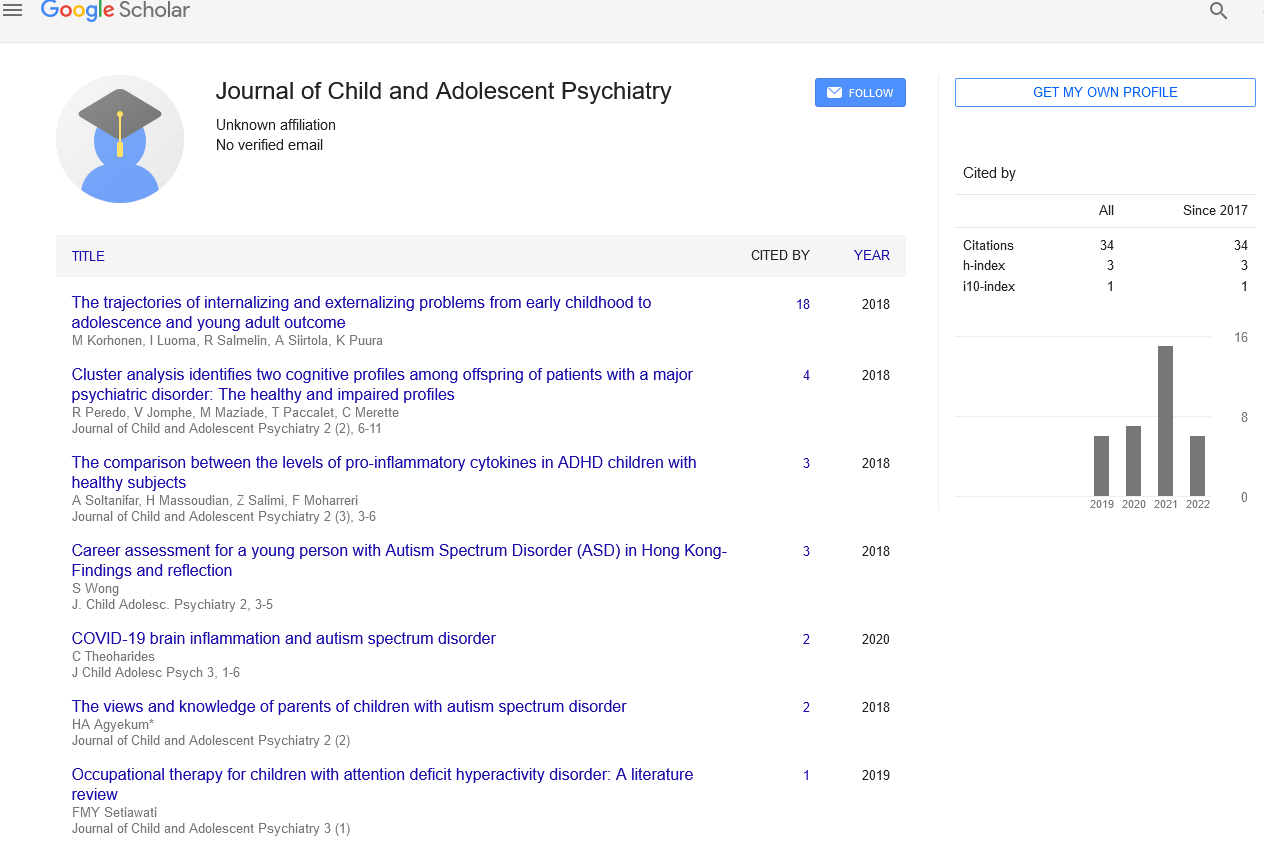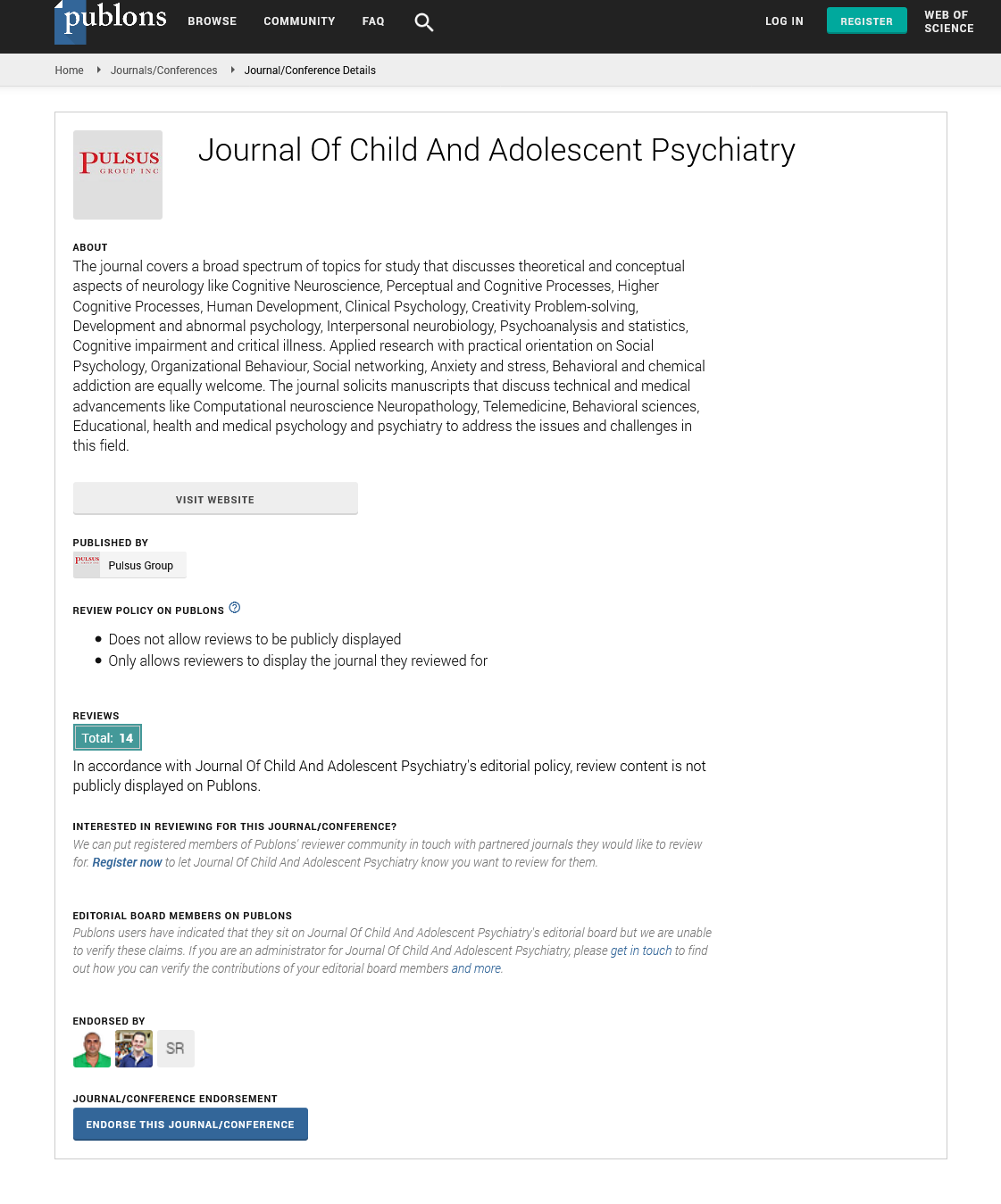Things inside teenagers mind
Received: 21-Jan-2022, Manuscript No. PULJACP-22-4721; Editor assigned: 23-Jan-2022, Pre QC No. PULJACP-22-4721(PQ); Accepted Date: Mar 09, 2022; Reviewed: 27-Jan-2022 QC No. PULJACP-22-4721(Q); Revised: 03-Mar-2022, Manuscript No. PULJACP-22-4721(R); Published: 13-Mar-2022, DOI: 10.37532/puljacp.2022. 6(2)-11-12
This open-access article is distributed under the terms of the Creative Commons Attribution Non-Commercial License (CC BY-NC) (http://creativecommons.org/licenses/by-nc/4.0/), which permits reuse, distribution and reproduction of the article, provided that the original work is properly cited and the reuse is restricted to noncommercial purposes. For commercial reuse, contact reprints@pulsus.com
Abstract
The existences of youngsters are unique about the existences of kids. This time of life is puberty, the time of life between adolescence and adulthood is a period of both social and organic changes. Public activity turns out to be more perplexing during puberty, and the teen years are the period when we sharpen our abilities for exploring the social world. These capacities are reflected in the progressions happening in the cerebrum. We realize that the region of the cerebrum affected by getting others and anticipating their activities are going through changes during immaturity. Thus, this may be a period when we are additional delicate to signals from individuals around us and the occasions in our public activities.
LETTER
Adolescence, which comes from the Latin word adolescere, signifying "to grow up," is utilized to portray the time of life among youth and adulthood. It is regularly characterized as beginning around Puberty and finishing when an individual has fostered an autonomous, stable job in the public arena. Youthfulness is certainly not another peculiarity. Antiquated people experienced youthfulness and Aristotle (384-322 BCE) was one of the first to record and remark on the progressions in the manner individuals think and act during this period. Trademark ways of behaving of youth, for example, elevated hesitance, curiosity looking for risktaking, and investing more energy with companions, are for the most part major to the effective change into adulthood. Social impacts, similar to others' thought processes of us, assume a major part in the manner in which we feel and act. Researchers from around the world have shown that young people are especially delicate to their social climate. This can mean numerous things. For instance, numerous teenagers care about the conclusions (both great and terrible!) of their companions or companions, at times considerably more than about those of relatives. One method for estimating that we are so delicate to the conclusions and activities of others is by estimating how terrible we feel after being barred from a multiplayer game. One such game, called "cyber ball," includes members playing a round of "get" with two different players. The member can be remembered for the round of catch or prohibited by different players. Shows a model liveliness of what it would resemble to be rejected in the cyber ball game. At the point when teenagers are barred by different players in this game, they report feeling more terrible and more restless than grown-ups (even though grown-ups could do without being rejected by the same token). Realizing that youths can feel contrastingly to grown-ups in friendly circumstances can assist us with understanding how young people decide. Our activities and the manners by which we decide to act are the aftereffects of a consistent stream of choices we are making. To settle on these choices, we need to take all the data we have that is applicable and weigh up regardless of whether it is smart to act. This dynamic interaction can be considered a sort of teeter-totter. Every one of the reasons for doing an activity - the positive results - is put on the "Yes" side of the teeter-totter, while the adverse results are put on the "No" side. More seasoned kids and youths can see similarly as well as grown-ups whether something positive or negative is probably going to occur because of an activity, a cycle called risk insight. This concludes which side of the teeter-totter the result goes on. One thing that might contrast between teenagers and grown-ups is how much worth they put on the great and terrible results, or how "weighty" every one of the results is on the teeter-totter. Youths will more often than not rate likely compensations as exceptionally high, which might make the apparent advantages (great results) offset the apparent gamble (awful results).
There are numerous results of a choice. While certain results of hazardous choices are sure or negative and remain somewhat steady (e.g., genuine wellbeing gambles from smoking), the worth of different results of a choice could shift contingent upon the social climate. For instance, although we comprehend the broad well-being dangers of smoking, the social results of smoking are variable. Socially, smoking can prompt companion acknowledgment and notoriety, yet can likewise prompt social disgrace and dissatisfaction, contingent upon the mentalities and assessments of your gathering of companions and your loved ones. Social results shift among people and can be the explanation that the dynamic teeter-totter tips somehow, change the choices we make and how we act in various socials settings. The teeter-totter model can assist with making sense of why various individuals pursue various decisions by featuring the worth of social results in navigation. These social results are believed to be especially significant in pre-adulthood. Utilizing this model could make it more obvious why youngsters (and kids and grown-ups!) go with unsafe choices. Researchers have started to interface these progressions in thinking and conduct to changes happening in the juvenile cerebrum. We realize that the mind is changing both in its capacity (how it processes data) and its actual design (or life systems). Various examinations have investigated what's going on in the mind when we attempt to get the considerations, sentiments, and expectations of others. These investigations utilize an innovation called Magnetic Resonance Imaging (MRI), which permits us to see what's going on in the living human mind. One MRI procedure, practical MRI, utilizes strong attractive fields to identify the degree of bloodstream in the various areas of the mind. Regions enacted during a movement need more oxygen to assist them with working, and this oxygen is moved around the body in red platelets. Useful, MRI estimates how much blood is being shipped off a region of the mind to decide if that region is enacted during a movement. The sign it measures is called the BOLD sign. To see more about the advancement of these "social mind" regions, we can likewise take a gander at how their actual design changes in youthfulness. We can do this utilizing one more sort of MRI called underlying MRI, which envisions the constructions that make up the cerebrum. Various pieces of the cerebrum contain various measures of water, which is comprised of hydrogen iotas and oxygen particles. At the point when these molecules are placed in a huge attractive field like the one created by the MRI scanner, they radiate trademark energy designs, contingent upon which structure they are a piece of. The scanner distinguishes these distinctions, and utilizations them to develop a 3D picture of the filtered region of the body. A review from our lab took a gander at the cerebrums of an enormous gathering of kids, youths, and grown-ups who matured 7-30. The actual construction that we estimated is called Cortical dim matter volume, which is a surmised proportion of the synapses and their associations, as well as supporting cells found on the external most layer of your mind (the cortex). We observed that these social mind regions keep on growing fundamentally all through youth, before moderately balancing out in the mid-twenties. All in all, the design of these social mind regions is as yet changing in adolescence and adulthood. Immaturity is a period of chance for mastering new abilities and manufacturing a grown-up character. We presently have a collection of logical proof exhibiting that the juvenile cerebrum is proceeding to create. This continuous change, especially in the region of the mind affected by getting others, could demonstrate that youthfulness is the point at which our cerebrums are particularly delicate to social learning and encounters. Maybe the capacities that arise during youth improve social signals or permit them to be all the more handily incorporated into different cycles. If so, then the intricacies of the juvenile climate, and the amazing open doors accessible to youngsters, may fundamentally affect how youngsters' cerebrums are formed.
Keywords
Adulthood; Adolescere






